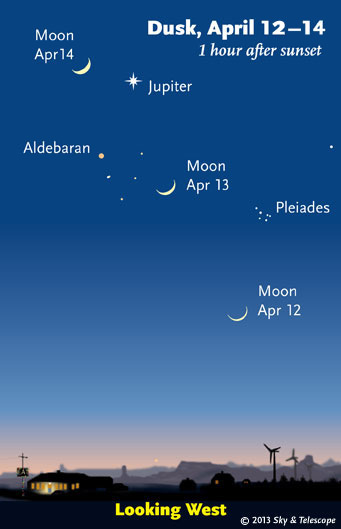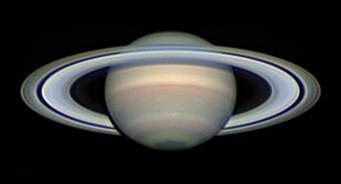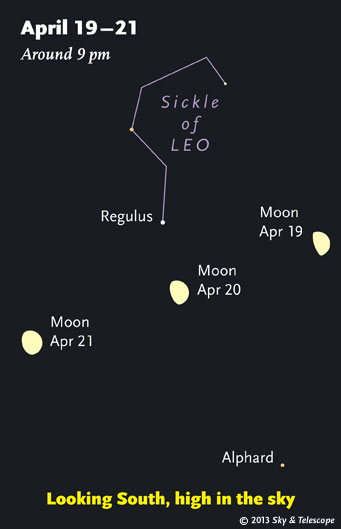
Day by day this weekend, the waxing crescent Moon marches up past stars and bright Jupiter. (The Moon is shown positioned for the middle of North America. For Europe, move each Moon symbol a quarter of the way toward the one for the previous date.)
Friday, April 12
Saturday, April 13
Sunday, April 14
Monday, April 15
Tuesday, April 16
Wednesday, April 17
Thursday, April 18
Friday, April 19
Saturday, April 20
Want to become a better amateur astronomer? Learn your way around the constellations. They're the key to locating everything fainter and deeper to hunt with binoculars or a telescope.
For an easy-to-use constellation guide covering the whole evening sky, use the big monthly map in the center of each issue of Sky & Telescope, the essential guide to astronomy. Or download our free Getting Started in Astronomy booklet (which only has bimonthly maps).
Once you get a telescope, to put it to good use you'll need a detailed, large-scale sky atlas (set of charts).

The Pocket Sky Atlas plots 30,796 stars to magnitude 7.6 — which may sound like a lot, but that's less than one star in an entire telescopic field of view, on average. By comparison, Sky Atlas 2000.0 plots 81,312 stars to magnitude 8.5, typically one or two stars per telescopic field. Both atlases include many hundreds of deep-sky targets — galaxies, star clusters, and nebulae — to hunt among the stars.
Sky & Telescope
The standards are the little Pocket Sky Atlas, which shows stars to magnitude 7.6; the larger and deeper Sky Atlas 2000.0 (stars to magnitude 8.5); and the even larger Uranometria 2000.0 (stars to magnitude 9.75). And read how to use sky charts with a telescope.
You'll also want a good deep-sky guidebook, such as Sue French's Deep-Sky Wonders collection (which includes its own charts), Sky Atlas 2000.0 Companion by Strong and Sinnott, the bigger Night Sky Observer's Guide by Kepple and Sanner, or the beloved if dated Burnham's Celestial Handbook.
Can a computerized telescope replace charts? Not for beginners, I don't think, and not on mounts and tripods that are less than top-quality mechanically (able to point with better than 0.2° repeatability). As Terence Dickinson and Alan Dyer say in their invaluable Backyard Astronomer's Guide, "A full appreciation of the universe cannot come without developing the skills to find things in the sky and understanding how the sky works. This knowledge comes only by spending time under the stars with star maps in hand."
This Week's Planet Roundup
Mercury is buried deep in the glow of dawn.
Venus and Mars remain hidden behind the glare of the Sun.
Jupiter (magnitude –2.1, in Taurus) is the first "star" to come out in the west after sunset. It descends through the evening and sets around 11 or midnight. Below Jupiter is orange Aldebaran. Farther to Jupiter's lower right are the Pleiades. In a telescope, Jupiter has shrunk to just 35 arcseconds wide.

Saturn on April 15th, imaged by Christopher Go in the Philippines using a Celestron 14 scope and a Point Grey Research monochrome Flea3 (ICX618) camera with Chroma Technology LRGB color filters. South is up. "The polar hexagon is prominent on this image," he writes. "Note the white spots on the North North Temperate Zone."
Christopher Go
Saturn (magnitude +0.2, in Libra) glows low in the east-southeast by the end of twilight. Look for it well to the lower left of Spica, and farther lower right of brighter Arcturus. Saturn rises higher all evening. It shines highest in the south around 1 or 2 a.m. daylight saving time — more or less between Spica to its right, and Delta Scorpii (and then Antares) farther to its lower left. Saturn will reach opposition on the night of April 27th.
Uranus is out of sight behind the Sun.
Neptune (magnitude 7.9, in Aquarius) is very low in the east-southeast just before dawn.
All descriptions that relate to your horizon — including the words up, down, right, and left — are written for the world's mid-northern latitudes. Descriptions that also depend on longitude (mainly Moon positions) are for North America. Eastern Daylight Time (EDT) equals Universal Time (also known as UT, UTC, or GMT) minus 4 hours.
Like This Week's Sky at a Glance? Watch our SkyWeek TV short. It's also playing on PBS!
To be sure to get the current Sky at a Glance, bookmark this URL:
http://SkyandTelescope.com/observing/ataglance?1=1
If pictures fail to load, refresh the page. If they still fail to load, change the 1 at the end of the URL to any other character and try again.
 0
0

Comments
You must be logged in to post a comment.